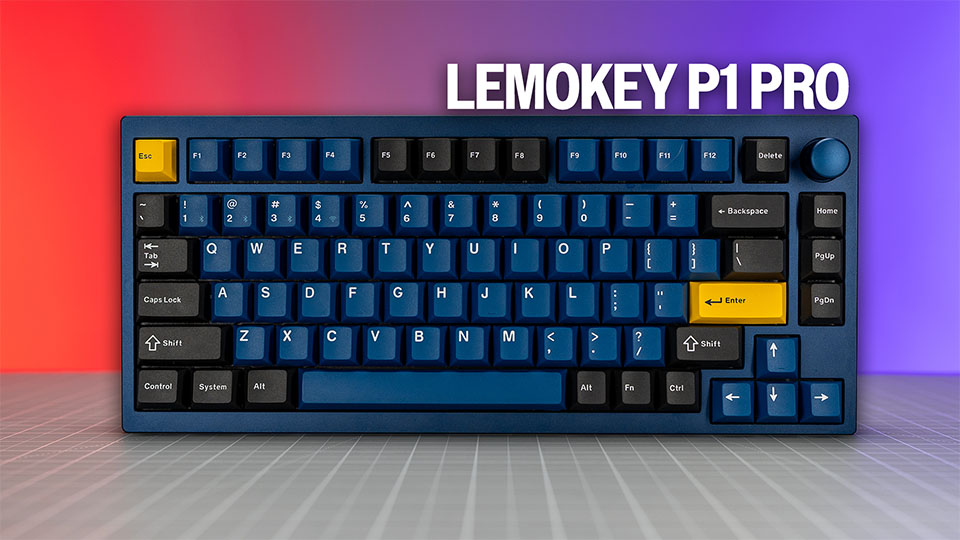Links in this post may be affiliate links. Any products purchased through affiliate links may provide a small commission which helps to support the SemiPro Tech+Gear site and YouTube channel.
Lemokey is Keychron’s gaming-focused brand that launched in 2023. The P1 Pro is a 75% model that may look like a lower-priced Q1 Max on paper, but this is not just another Keychron keyboard.
The price definitely makes the P1 Pro look like a better value than the Q Max line from the parent brand, considering it offers all the same core features. But that doesn’t mean it’s better for every person, because there are some differences we need to talk about. So let’s take a closer look at the P1 Pro from Lemokey. A full video review is embedded below as well as my written summary. Before we dive in, my usual disclaimer: Keychron sent me the P1 Pro for the purpose of reviewing it. I was not paid for my review and Keychron had no input on my comments.
Lemokey P1 Pro
MSRP: $129.00 (wired only model available for $109)
Pros
- Excellent build quality for this price point
- Stable wireless with 1,000Hz polling (2.4GHz)
- Nice quality keycaps
- QMK VIA customization (and Keychron Launcher)
- 200hrs battery life (lights off)
- Available in ISO layout
Cons
- Typing feel is a bit stiff considering it’s gasket-mounted
- Stabilizers are just ok – spacebar is quite chattery
- Out of the box sound could use some tuning
Best For: When you want a gaming-focused board with some custom keyboard perks.
Features and Specifications
The P1 is available in wired-only and “Pro” versions, and the unit I had for testing was the Pro version with bluetooth and 2.4GHz connectivity. On paper, the P1 Pro looks a lot like Keychron’s Q1 Max. It shares the same 75% layout, same wireless connections and polling rates, an all-metal build, and QMK firmware. The biggest difference? The price. The P1 Pro is $129 while the Q1 Max is $209. There are also some less obvious differences, so let’s review some more details.
Build
The case is full CNC aluminum, and the anodized finish is more sleek than the more textured finish on the case of the Q1 Max. There is also a mirror-finish accent on the case bottom which is a common trait of custom keyboards, and notably not present on any of the Q Max keyboards. The front height is just a tad lower at 19.2mm, and the weight of 1,650g is just slightly less than the Q1 Max. That is still a hefty 3.6lbs, so no need to worry about it feeling too light. Color options include black, silver, and blue. I really like the look of the blue option and the keycaps match the case color quite well. One other physical difference of note from the Q1 Max is that they moved the case screws from the outside/bottom of the case to inside the key area, under the keys. There are six screws that you have to remove keycaps to reach, which is a step towards discouraging customization/mods. They do, however, still include screwdrivers in the box, so that’s a bit of a mixed message.
Connectivity & Battery Life
Wireless connectivity includes bluetooth for three devices and 2.4GHz. Both the 2.4GHz and USB-C wired connections feature 1,000Hz polling which are best for gaming as the bluetooth polling rate is only 90Hz. The battery capacity is 4,000mAh but the battery life is a bit better than the Q1 Max, with an estimated 200hrs max life when all the lighting is turned off (vs 180 for the Q1 Max). That reduces to a max of 100hrs with lights on the lowest setting (and down from there as you turn up the brightness).
Backlighting
Backlighting is per-key RGB however it is south-facing. For custom keyboards this typically is a non-issue and this position avoids any potential keycap/switch contact in the very low row 3 of cherry profile keycaps. However gaming keyboards often include shine-through keycaps for low-light visibility, and north-facing backlight is best for this because keycaps often have legends towards the top of the keycap, not the bottom. The P1 and P1 Pro do not come with shine-through keycaps (however they are very nice quality), so if you want to add shine-through keycaps yourself you’ll want to make sure they do not have legends in the top corner because the lights won’t illuminate them well. Front-facing side legends would be the best option, though not everyone loves side legends (me included).
Internals & Switch Options
Internals have some distinct differences from the Q1 Max, most notably with the gasket-mounting. Keychron has long used a foam sandwich gasket mount in their Q line of keyboards, which involves a squishy poron foam strip on both the top and bottom of the plate which seat between the top and bottom of the case, suspending the whole PCB/plate assembly and allowing it to move up and down quite a bit while typing – it’s decidedly bouncy, especially if you remove the foam in the case bottom.
The P1 Pro ditches the foam sandwich for silicone button/bean style gaskets attached to the PCB, and there are two sets provided. The installed set is the harder/stiffer set, and there is a softer/squishier set in the box if you prefer a more cushioned feel. I swapped them out for the softer set and removed the case foam to see how much movement I could get, and it was still nowhere near as much flex as the Q Max keyboards. It does feel cushioned and not stiff, but also not bouncy. The plate is PC with flex cuts, but that doesn’t seem to add a lot of flexibility.
The switch options are also different from the Q Max line. The P1 offers Keychron “Super” switches in red, brown, and banana varieties. Reds are linear and brown & banana are tactile. The reds in my unit felt slightly heavier and snappier than the Gateron Jupiter red switches I’ve tested (which come in the Q1 Max), even though the actuation force is the same at 45g. The reason they feel a bit different is because the Super switches use a dual-stage spring while the Jupiter switches use a single-stage spring. Overall I liked these switches a bit more than the Jupiter switches – they were not pingy or overly scratchy.
Customization
Gaming keyboards are often targeted at Windows users as the majority of gaming takes place on Windows setups, and Lemokey leaned in that direction for the P1 Pro. Keychron includes pre-programmed Mac and Windows modes on their keyboards, sometimes with a physical switch and sometimes with a key command, that swaps the modifier keys so that Mac users have the proper keys assigned to command and option functions. They opted to completely leave this out with the Lemokey P1 – it is set up for Windows out of the box and there is no switch or key command to swap to a Mac mode.
However, the P1 still has QMK firmware, generally preferred by custom keyboard enthusiasts because it allows for easy customization including remapping the keys, creating macros, and setting up different layers to perform different functions. Thanks to the web tool VIA, I was easily able to create my own Mac layer and toggle command to switch between the Windows and Mac layouts. So while this is not set up out of the box like it is on Keychron’s main line of keyboards, it was easy enough to get the same result thanks to the QMK firmware. The P1 and P1 Pro are also compatible with Keychron’s own Launcher web app, which works similarly to VIA but also supports additional keyboards that are not supported by VIA, like the ultra-low profile Keychron B1 Pro. So whichever app you choose for customizing, you don’t have to worry about installing third-party software from unknown sources that will trigger antivirus software alerts.
Pros and Cons
There is a lot to like with the P1 Pro, especially for the price point relative to the competition.
Pros
- The build quality is very good – nice machining, nice mirror accent, and not the thinner, more lightweight aluminum you sometimes see in this price range. It’s as solid as keyboards that cost nearly double.
- The wireless connectivity was stable for me and 2.4GHz offers 1,000Hz polling which is useful for gaming.
- The keycaps are very good quality – nice full double-shot, crisp and consistent legends, and good PBT texture. I like these keycaps better than the KSA keycaps that come on the Q1 Max. And the color matches the case well.
- QMK firmware with customization available through the VIA web app as well as Keychron Launcher web app (no janky software to download!).
- Battery life is respectable for a QMK keyboard at 200hrs (lights off).
- Available in an ISO layout, so more people around the world can enjoy it.
- Overall what you get for the price is a better value than Keychron’s Q Max line.
The P1 Pro is not perfect, however, and there are a few things that could be improved.
Cons
- The main con that applies to everyone (meaning it’s less subjective) is that the stabilizers are just ok. The spacebar on my unit had what I would call excessive rattle/chatter – see the video above for the sound test. They are PCB-mounted and simple to replace if you’re so inclined.
- There is no storage for the 2.4GHz receiver on the keyboard, so if you’re not using it and you’re not keeping the box, the receiver will be relegated to your desk drawer where things can be easy to lose.
- This one is nit-picky and won’t bother some people at all. The USB-C port on the back of the P1 Pro is not in the center of the keyboard, nor is it significantly off to one side. It’s kind of just slightly off-center in a position that looks weird to me. If you plan on only using wireless connections that won’t be an issue.
- Lastly, I’m not in love with the sound profile out of the box. This is very subjective and there are no sounds that I would classify as “terrible” but it also needs some attention to sound its best in my opinion. It has a bit of metallic resonance and of course the stabilizers don’t help. I personally removed the case bottom foam and added force breaks and a tape mod, which helped the overall sound. If you enjoy doing these things then it won’t be a big deal, but I count it as a con when a prebuilt keyboard doesn’t sound great out of the box because at least some buyers are just going to use it as-is.
Is it Worth It?
So is the P1 Pro worth it if you’re in the market for a 75% keyboard? Well, it depends on your priorities. In my opinion there is a little bit of a mixed message here in terms of who it really appeals to. There are some great custom keyboard features like gasket mounting (albeit on the firmer side), QMK firmware, and quality cherry profile keycaps. But then the case screws are located in a place that’s harder to get to and it’s clearly targeting Windows users with its default setup, so that leans towards gaming.
Ultimately I think it’s a great set of features and quality for the price, but in my opinion it’s best suited to gamers who would like some of the perks of a custom keyboard, while custom keyboard purists who do little to no gaming may see some reasons to pass. For myself, as purely a keyboard nerd and not a gamer, I’ll stick with the Q1 Max even though it’s more expensive because the foam gasket mounts provide more of the feel I prefer and it’s designed to be easy to open up and customize. I might steal the keycaps from the P1 Pro though.
Check out the Lemokey P1 Pro
Keyboard Specs:
Price: $109 (wired only) / $129 (wireless)
Layout: ANSI 75% | 84 keys (ISO layout available)
Switch Options: Keychron Super Red, Brown, Banana
Hot-swappable: Yes
Connectivity: Bluetooth for 3 devices, 2.4GHz (1kHz polling), USB-C wired (1kHz polling)
OS Compatibility: mac/windows/linux (set up for Win by default)
Typing angle: 5.5º
Frame: Aluminum
Bottom case: Aluminum
Keycap: PBT, double shot, cherry profile
Dimensions: 322 x 140 mm
Front Height: 19.2mm
Rear Height: 31.4mm
Weight: 1650g / 3.6lbs
Battery Capacity: 4000mAh


